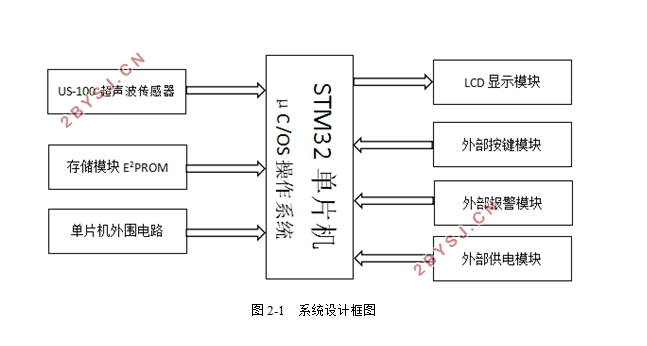基于嵌入式系统的超声测距系统设计
无需注册登录,支付后按照提示操作即可获取该资料.
基于嵌入式系统的超声测距系统设计(论文12000字)
摘要:超声波测距传感器因为它的高性能、低价位、以及方便性,在工业工作、 GPS导航、水声工程等相关的领域利用广泛,在空气这类气体介质中,超声波传播不太容易受到干扰,能量损耗比较缓慢,在空气中传播的距离相对远一点,因此在测量距离的时候通常会选择超声波。距离的测量在现实生活中有非常深远的意义,所以,深入研究利用超声波来测距的理论和方法具有更重要的实践意义。本系统包含硬件和软件两个子系统。硬件方面,主要是利用STM32位单片机,设计了具有通信、预处理等接口的硬件电路,完成对回波数据的采集、处理、上传等功能。软件方面,利用μC/OS嵌入式操作系统,Keil的软件环境编写程序,实现测距、数据存储及报警的功能。
关键字:STM32;超声波传感器;嵌入式;报警
Design of Ultrasonic Ranging System Based on Embedded System
Abstract:The ultrasonic ranging sensor has been widely used in industrial work, GPS navigation, underwater acoustic engineering and other fieldsbecause of its high performance and low price, and convenient, in this kind of gas air medium ultrasonic propagation less susceptible to interference, the energy loss is relatively slow, spread in the air of the distance is relatively far away, so when the ultrasonic distance measurement usually choose. Distance measurement has very profound significance in real life, so it is of more important practical significance to study the theory and method of ultrasonic ranging. The system contains two subsystems of hardware and software. In hardware, the hardware circuit of communication, pretreatment and other interfaces is designed by using STM32 bit microcontroller. The functions of collecting, processing and uploading the echo data are completed. Software, using C/OS embedded operating system, Keil software environment to write procedures to achieve ranging, data storage and alarm function.
Keywords: STM32;Ultrasonic sensor; embedded;alarm system

目 录
摘要 1
Abstract 2
一、引言 3
1.1课题研究的目的和意义 3
1.2超声测距国内外现状 3
二、方案设计与论证 3
2.1硬件功能的设计 3
2.2设计方案的论证 4
2.2.1 STM32微控制器的选型 5
2.2.2 US-100超声波传感器的选定 6
2.2.3显示屏LCD1602的选定 6
三、超声波测距的硬件参数 6
3.1 STM32单片机的工作原理 7
3.2超声波传感器的工作原理 9
3.3显示屏LCD1602的具体参数 11
3.4按键、蜂鸣器的工作原理 11
3.5存储芯片24C02的工作原理 12
四、超声波测距系统的软件设计 13
4.1软件开发环境Keil的简介 13
4.2程序流程图 13
4.3基于操作系统的任务实现 14
4.3.1 μC/OS操作系统的简介 14
4.3.2各部分程序实现的功能 15
五、测试结果与分析 19
5.1分模块调试与检测 19
5.2实验结果与分析 20
六、结论 22
参考文献 22
致谢 24
